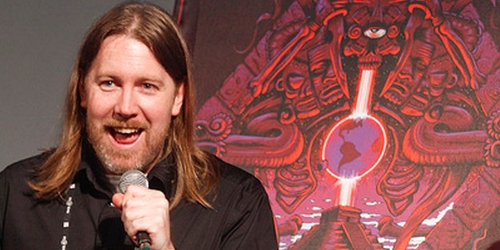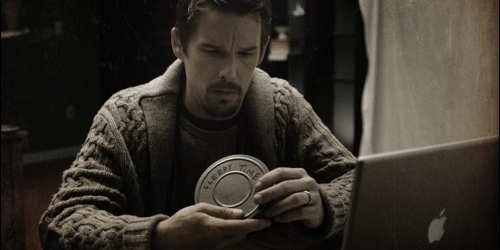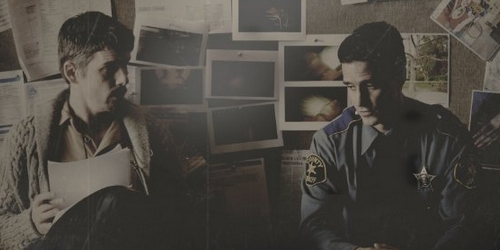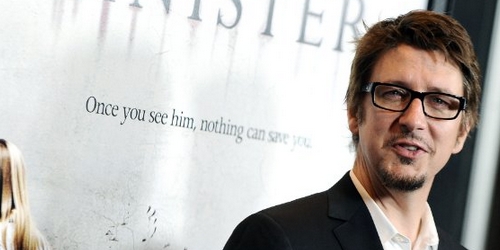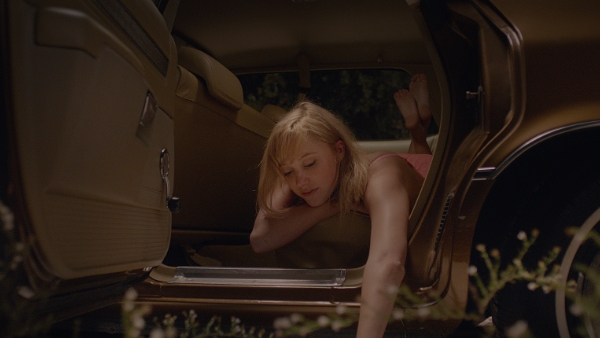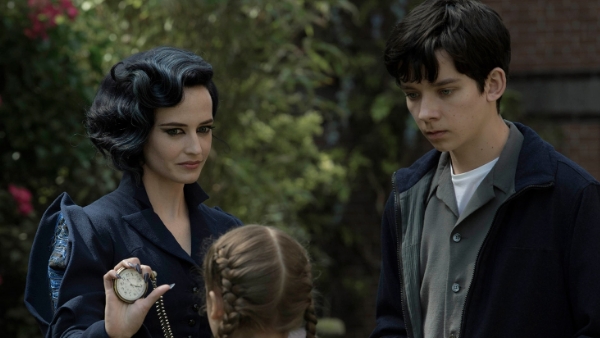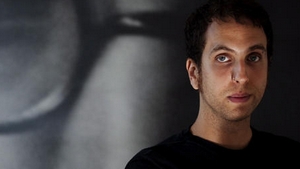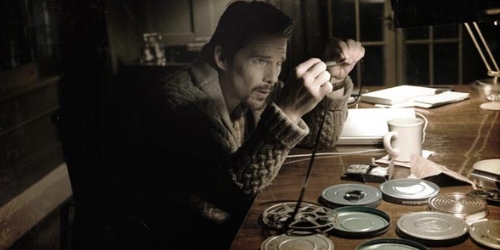 It’s been a long standing and understood notion that it is getting tougher and tougher to scare movie goers. Sometimes however, a film comes along which takes us by surprise and really give us chills. Not jump scares mind you, or excess for the sake of excess, but legitimately scary sequences that stay with us long after leaving the theater. One such film that fits the bill is the brainchild of on C. Robert Cargill and director Scott Derrickson. The duo knows their stuff and getting away from purely trite hack/slash horror that populated the 80’s, they offer not only an ultra tense ride that is pure nightmare fuel, but tangible characters that the audience can actually get behind.
It’s been a long standing and understood notion that it is getting tougher and tougher to scare movie goers. Sometimes however, a film comes along which takes us by surprise and really give us chills. Not jump scares mind you, or excess for the sake of excess, but legitimately scary sequences that stay with us long after leaving the theater. One such film that fits the bill is the brainchild of on C. Robert Cargill and director Scott Derrickson. The duo knows their stuff and getting away from purely trite hack/slash horror that populated the 80’s, they offer not only an ultra tense ride that is pure nightmare fuel, but tangible characters that the audience can actually get behind.
At the 2012 Fantastic Fest, Go,See,Talk got to visit with the duo to talk about their love/knowledge of horror films and discuss Sinister (check out our review here). Below are the excerpts from our time with them both. It’s a long interview but we covered a lot of material. Hope you enjoy it.
[FYI – There is a SPOILER in the very last question/answer…be advised!!]
————————————————————————————————————————————————-
– First thing I wanted to say is that it was refreshing to see a horror film with some realism and a solid human/family element. Also that you took time to explore that and let it play out, like in Ellison’s lengthy bedroom argument with his wife, to show how the events are really affecting the family as opposed to the great kills or jump scares we see so often.
Cargill: When you look at the greatest horror movies ever made and the greatest horror movies ever made are mostly family dramas. They’re really about something and character dramas. The Exorcist is about a woman grieving over her daughter Look at The Shinning which is about the breakdown of the family. The Omen, Rosemary’s Baby, Poltergeist, all the great horror movies have human elements and are about characters you really care about so once you get invested in them, once anything happens to them you feel it so when becomes powerful and supernatural it scares the crap out of you.
I think one of the biggest problems that’s happened in horror was what happened with slasher films in the 80s. Everyone just thinks, oh, all you have to do is put a couple of teenagers in a cabin somewhere and kill them and people will be scared. But no, we don’t get scared. There’s this whole offshoot of horror that kind of became a comedy which is how a bunch of us critics became obsessed with and love great kills because that’s all those movies were offering us.
You’re never going to find a real character anywhere in a Friday the 13th move. What you’ll find is really interesting kills and the same formula executed over and over again, but it’s absolutely essential in a horror movie to scare the audience. But not just because it’s scary but because they care about the characters. Even The Ring, The Ring is another great example. Here’s the story of this mother and her son and that connection and once that connection happens you really do feel the fear.
– The entity in the film, The Bughuul is an interesting element which has a really cool mythology. Was he a pre-existing figure? Or can you talk about developing him?
Cargill: He’s entirely original. We created him from a whole cloth. The canon came from what we wanted to do with the movie and the mythology came from books on folklore and demonology, finding common threads and creating something that felt familiar but wasn’t a carbon copy of anything.
– How much research went into that?
Cargill: About a week. One week of me sitting down with books on my couch and just kind of sifting through it. I’m a novelist as well and so I’ve got tons of books on all sorts of manner of folklore and so it’s something that I read in my free time. I have a whole stack of books right now, I’m boning up on Australian dream time mythology and so I’ve got a dozen books on that. So it’s just stuff that I knew and I was going back trough and rereading to look specifically for those threads and that took about a week.
– One great idea in the film was combining the fantastical element of Bughuul with the true-crime writer plot point. Did you two find yourselves doing a lot of true-crime research, specifically how someone like Ethan would attempt to do this in the film?
Derrickson: I’ve read a lot of true crime and I like good true-crime writing. I never really made this connection but I actually spent 2 years, not long ago, writing the script for The Devil’s Knot which is based on a true-crime book. So I spent a good long period of time totally immersed in the West Memphis Three murder case, so I’d gone through the whole process of flying to West Memphis and going through the police files and reading all the courtroom transcripts and learning everything about the individual crime. I’ve read at least a dozen good true-crime books in my life and it’s a fascinating sub-genre of writing. It’s a serious genre of writing for people who take it seriously and I love when Ellison [Ethan Hawke’s character] mentions in cold blood because the best of those books take on great literary value as well as exploitative grisly information.
– There was a wonderful balance between you ramping up the tension and then breaking it with a whole lot of hysterical humor. Then you’d jump right back to the tension and what really helped sell the intensity of those scenes was the awesome electronic score. How did you decide on that sound for the film as opposed to a traditional orchestra?
Derrickson: Yeah, Christopher Young was the composer. I knew I wanted to work with him again, he was the composer for The Exorcism of Emily Rose and he is, to me, pound for pound the best horror composer in the world. His score for The Grudge is my favorite horror score, it’s awesome.
Cargill: Oh his scores for the Hellraiser movies!
Derrickson: Sam Raimi used the Hellraiser score as his temp music for Spider-Man because it was so big and epic. He brought Chris in to do extra scoring for that movie. He’s just a great composer but he had never done anything electronic like this that was down and dirty and gritty and I talked to him about doing it and he was definitely game for doing it. So that was a really experimental process that started with him sending me hundreds of music samples of sounds and music that he was creating and I would tell him which ones I thought were great, which ones were scary and he would go and compose pieces. But he was also working around 9 prerecorded tracks, there’s a bunch of prerecorded music in the movie. All of the super 8 films have songs that I found online and bought the rights to before we started shooting.
So the challenge was for Chris’ score to seamlessly move in and out of those prerecorded songs and for the sound designer to do the same thing and i think the result is, because all the people working on it, the composer, the sound designer, the editor because they were not ego driven people, they were not fighting for their territory. Instead they were circulating lots of material, and the result to me is that you never really quite know whats pre-recorded music and what’s sound design and what’s score. The kind of seamlessly weave in and out of each other in a way that’s pretty unique I think. It’s one of the things I’m most please with about the film, the work that those people did in creating a soundtrack that’s not quite like anything I’ve heard before.
– Going back to the ebb and flow of the tension and humor, the deputy was a real voice of reason, something that horror films either under-utilize or tend to parody. Was he part of the original pitch or was he someone you added in?
Derrickson: He was not in the original pitch…
Cargill: No, no, he was someone we added in. We knew at some point we needed Ellison [Ethan Hawke’s character] to talk to the audience and explain the crime and what he was unveiling and Scott had recommended this deputy character. We had the situation happen and he said it’s the perfect point for a deputy to come in and he wrote a scene where this deputy came in and I said “look, I do not want Deputy Dewey [from Scream]. I do not want a bumbling character and so Scott said, “then don’t write it”. So we kind of played back and forth and then realized, “hey, what if we have this guy who is just starstruck? He’s actually a good cop and he’s smart and he really gets what’s going on but he seems like a bumbling tool at first because he’s completely overpowered by the presence of this guy who he idolizes”. Then what we slowly kind of unveil that because here’s a character who the protagonist doesn’t even get to know his name. He actually types him in his phone as “Deputy So and So”.
Derrickson: *laughs* Which says so much about Ellison!
Cargill: It does say so much about Ellison but by the time you get to the end of the movie, the deputy has figured out with half the information what Ellison has failed to realize with all the information. It’s fun watching the evolution of that and it’s just one of those things that the genre films I love most are the ones that have really great secondary and tertiary characters – characters that you get right away that are involving and have arcs. That was something that I really enjoyed with him was being able to write this character because you don’t see that kind of guy. That role is always just a stock character. In fact James Ransone played that same exact character, the deputy who is being bounced off in Prom Night, where he’s just the deputy following around the other police officers so the officers have someone to talk to and doesn’t have a chance to really stand out because he’s just there as a sounding board. So to actually be able to play to play with that and make that character well worth it was just so satisfying.
Derrickson: When shooting the movie, I knew that what you were describing was a tricky thing to do, to go from pretty serious horror and dread and all that to this comic relief and then get back into it. So I really bracketed his performance. In every scene there was a big comedic version and a medium comedic version and then a really low key comedic version. Then in editorial it’s interesting because we used all three in different places. I would say mostly they’re the low key ones but then we sort of picked our moments like “this is a moment to push the comedy a little more”. So because I had done that range of those performances we had, the editor had enough material to try different degrees of comedy. If we had gone all the way with an even tone when we shot it I don’t think it would have worked. It would have been uneven and luckily the editor was able to sculpt out of that something that moved with the movie.
– The majority of the film takes place in a relatively small ranch style home with narrow hallways, yet the way a lot of the shots are composed and filmed you have these wide shots. Doing that offers the audience a lot of space to look and search for something like Bughuul or anticipate a jump scare. Was the style of the house and the style of the shots intentional as far as the cinematography?
Derrickson: Well that was just part of the visual design. The starting point for me was that I didn’t want to have that same old scary looking two-story Psycho, Amityville, Haunting in Connecticut house. Haunted houses all look like they’re gonna be haunted you know, so the starting point was that I wanted a flat ranch style house with really long hallways.
Cargill: I remember that phone call too. Originally it was in the script it was a two-story house and you said “does it have to be two stories?” and I go, “I don’t know what you’re asking” and then you said exactly what you just said “I’m sick of every haunted house movie that is eactly the same. A big two-story house with a spooky window. Or maybe a three story house and the third story is the attic. Can we do something that is one story? And I go, “yeah! there’s nothing in the script that requires it”.
Derrickson: And to answer your question the tendency in film and even more so in horror is to shoot things one of two ways: it’s either found footage movies which are just phone cameras, video cameras and that sort of thing, or to shoot it filmically which means shooting on long lenses and compressing the space and giving it that sexy selective focus look. And I like that but for this movie the idea is that we make it very filmic and make it really dark and really push the contrast. I gave the movie Klute to the DP, to show him just how black Gordon Lewis’ photography is and shoot it with really wide lenses to make the space look big but also always have a sense of depth to it and to push the blackness around it because that makes it feel bigger.
It was not a big house and it wasn’t a set but when you shoot with wide lenses and you’ve got a lot of darkness in the frame, that darkness plays as infinite, like outer space. It makes it feel big and gives things that are illumined a deeper space. It becomes something that you feel and envelopes those characters. I think that that was a deliberate idea to give some character and give some filmic value to it that would service the story and that would keep the audience engaged with the space and the characters within it. I didn’t think particularly that something’s going to pop out back there.
– Well like the style of house, the wide shots were just one of the many refreshing elements. Before our time is up, can you talk about casting such powerful actors in smaller roles. Couldn’t you just get unknowns like the rest of the cast?
Cargill: Well they’re not unknowns, the daughter is from Win Win, Ethan’s wife [Juliet Rylance] is a famous stage actress and even the deputy [James Ransone] has been in a lot of things. What we wanted in this cast were people who as soon as the appeared on screen you wouldn’t question their legitimacy. Fred Thompson is the biggest swinging dick on the planet. When he walks in a room people take notice. Think about that scene in The Hunt for Red October where Baldwin comes in thinking he knows his shit and Thompson quickly puts him in his place. That’s what happened in Sinister, Fred actually started pushing Ethan around like he did, on camera, with Alec Baldwin. We we so glad to have him because of what he brought to the table. Another one was Vincent D’Onofrio. When he shows up no one would think to question him.
– Well then that’s my perception because I just don’t know the supporting cast from anything I’ve seen.
Cargill: But you have a point, there’s something to casting lesser known actors in some parts. People have this assumption that no harm could possibly come to a main character. Think of Jackie Chan, Jackie has one rule * imitates Jackie Chan* “Jackie Chan no die. In all of my movies, Jackie Chan no die. But if Jackie Chan die, he get reincarnated and come back to life, so…Jackie Chan no die”. It’s a bold move here to do what we did casting Ethan, who has never been in a horror movie or anything like this. No one expects Ethan to die and it’s just one of the ways we did things outside the norm with this.
Derrickson: From the start we wanted to make something distinctive, which is evidenced by all the choices we made, but we had an approach from day 1 as we were putting this together. Most of what was in the script, even going back to our initial pitch, is in the film because we decided a decision wouldn’t be made just so someone could get their way. The decision had to come from what was right for the story, the right idea about the characters, motivations, etc. That made us happy about all the choices we made and we think it helped the movie.
Congratulations guys, it’s a killer film. Thanks for your time.
Cargill: Thank you man.
Derrickson: Thanks a lot.
Thanks to Scott Derrickson and C. Robert Cargill for their time and to the Fantastic Fest organizers for arranging this interview. Sinister is in theaters now.

